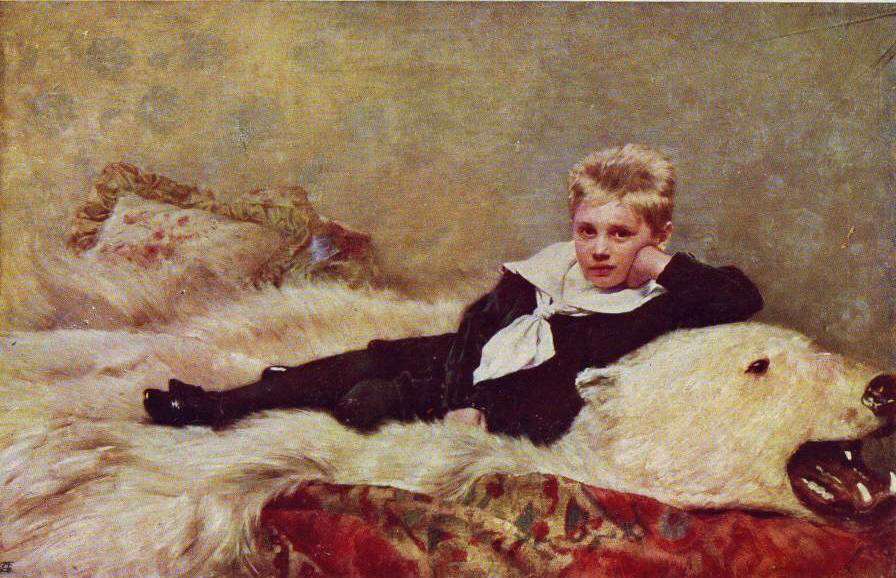
Marie Rosenthal-Hatschek (Austria, 1900s)

Figure 1.--We notice a painting by M. Rosenthal-Hatschek of an unidentified boy on a white bear skin rug. The painting is entitled "Siesta". The boys wears a smart sailor suit. the painting is not dated, but we would guess it comes from the turn-of-the 20th century. We have been unable to find any information about the artist.
|
|
We notice a painting by Marie Rosenthal-Hatschek of an unidentified boy on a white bear skin rug. The painting is entitled "Siesta". The boys wears a smart sailor suit. We know nothing about the boy, but suspect he was from an affluent Vienese family. He looks to be about 7-8 years old. A reader writes, "A white bear skin rug has to be a Polar Bear. This suggests a wealthy family. Hunting Polar Bears, especially at that time was a very rich man's sport! It is possible it could have been imported from Russia, but even that would have been expensive." The painting is not dated, but we would guess it comes from the early-1900s, almost certainly before World War I. I think a postcard like this (high-quality color lithography) would have before World War I been printed in Europe. In this case Austria or Germany. We have been unable to find much information about the artist. This is a little surprising because the painting seems like a quality piece of work. Marie Rosenthal-Hatschek was born in Lemberg (Lwow) (1871). The city is now in Poland, but at the time was part of the Austro-Hungarian Empire. Her name suggests that she was of Austrian/German ancestry. She studied art at the Akademie Wien in Vienna (1886-90). Afterwards more studies in Munich with the famous painter Lenbach. This would suggest she began painting in the 1890s. Marie Rosenthal-Hatschek was known in Vienna as a "Bildnissmalerin" (portraitist). She likely worked for rich Viennese families which is suggested by the portrait here. She participated in exhibitions and here name is mentioned in occassional Vienese newspaper articles. We do not know when she died.
Strangely the boy's sailor scarfe looks more American and German. The postcard was distributed by an American company, W.R.B. & Co. The postcard comes from Galerie Wiener in Austria. Perhaps HBC readers will know more about the artist.
Unidentified Boy
We notice a painting by Marie Rosenthal-Hatschek of an unidentified boy on a white bear skin rug. The painting is entitled "Siesta". The boys wears a smart sailor suit. We know nothing about the boy, but suspect he was from an affluent Vienese family. He looks to be about 7-8 years old. A reader writes, "A white bear skin rug has to be a Polar Bear. This suggests a wealthy family. Hunting Polar Bears, especially at that time was a very rich man's sport! It is possible it could have been imported from Russia, but even that would have been expensive." One interesting question is why this portrait was reproduced on a postcard. Presumably the portrait was a commission. Thus the family's permission was needed. We wonder why the family would have wanted it sold in postcard form.
Chronology
The painting is not dated, but we would guess it comes from the early-1900s, almost certainly before World War I. I think a postcard like this (high-quality color lithography) would have before World War I been printed in Europe. In this case Austria or Germany. The postcard was distributed by an American company, W.R.B. & Co.
The Artist
We have been unable to find much information about Marie Rosenthal-Hatschek. This is a little surprising because the painting seems like a quality piece of work. Marie Rosenthal-Hatschek was born in Lemberg (Lwow) (1871). The city is now in Poland, but at the time was part of the Austro-Hungarian Empire. Her name suggests that she was of mixed ancestry. Rosenthal was of Austrian/German ancestry. Hatschek was of Czech origins. The combination as a result of centuries of Austrian rule is very Viennese. Rosenthal-Hatschek studied art at the Akademie Wien in Vienna (1886-90). Afterwards more studies in Munich with the famous painter Lenbach. This would suggest she began painting in the 1890s. Marie Rosenthal-Hatschek was known in Vienna as a "Bildnissmalerin" (portraitist). She likely worked for rich Viennese families which is suggested by the portrait here. She participated in exhibitions and here name is mentioned in occassional Vienese newspaper articles. We do not know when she died. The postcard comes from Galerie Wiener in Austria. She was important enough for her work to have been reproduced in postcard form.Perhaps HBC readers will know more about the artist.
Clothing
The boy wears what looks like a velvet sailor suit with bloomer knickers. His collar is all white. Stripes were more common, but these all white collars were also popular at the time. He has matching long stockings. He also wear black patent leather strap shoes. Strangely the boy's sailor scarfe looks more American and German.
Sources
Thieme, Ulrich and Felix Becker. Ed. Allgemeines Lexikon der bildenden Künstler des 20. Jahrhunderts 25 vols. (General lexicon of creative artists of the 20th century). This is a well-known standard work in art libraries.
HBC

Navigate the HBC Art pages:
[Return to the Main Austrian national art page]
[Return to the Main individual artist M-R page]
[Chronology]
[Country]
[Individual Artists]
[Styles]
Navigate related Boys' Historical Clothing Web Site pages:
[Return to the Main Austrian page]
[Long hair]
[Dresses]
[Collar bows]
[Kilt suits]
[Kilts]
[Fauntleroy suits]
[Sailor suits]
[Velvet suits]
[Peter Pan collars]
Navigate the Historical Boys Clothing Web Site:
[Introduction]
[Activities]
[Biographies]
[Chronology]
[Clothing styles]
[Countries]
[Bibliographies]
[Contributions]
[FAQs]
[Glossaries]
[Images]
[Links]
[Registration]
[Tools]
[Boys' Clothing Home]
Created: 12:14 AM 9/20/2010
Last updated: 6:39 AM 9/21/2010



